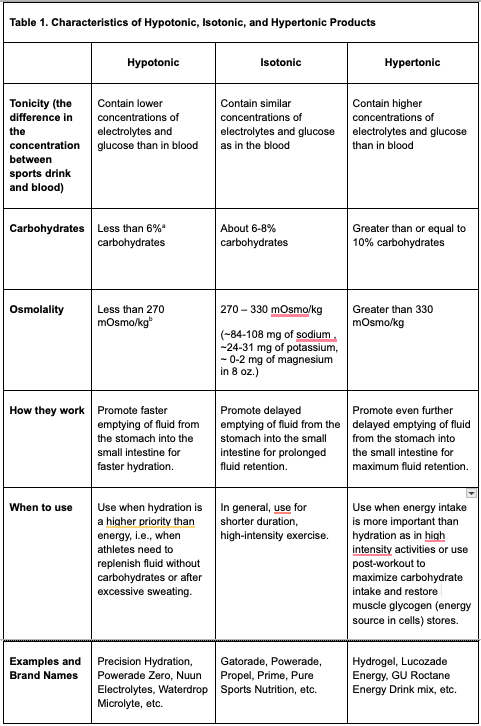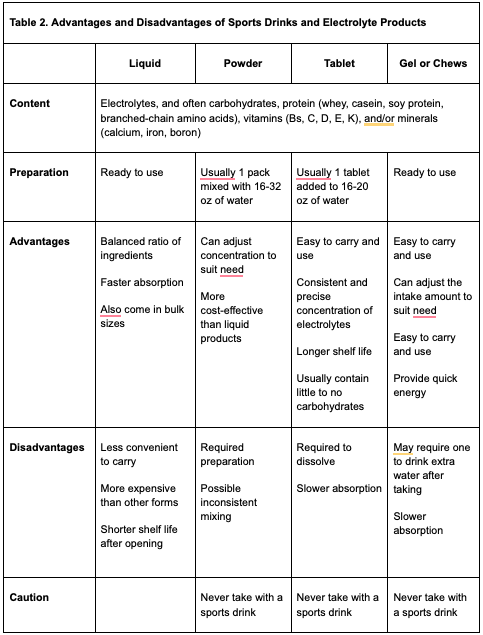Sports Drinks and Electrolyte Products
Young Ju, Ph.D.
Sports Drinks and their Ingredients
Sports drinks are non-carbonated flavored drinks containing added electrolytes and carbohydrates (sugar, or other sweeteners) to help replenish fluids, electrolytes, and energy in the body during and after high-intensity exercise lasting over an hour (1). Sometimes sports drinks also contain protein, vitamins, and/or minerals; sugar-free products are also available. The U.S. Food and Drug Administration regulates them as foods and beverages, and they can be marketed as both a food or a dietary supplement (2).
Carbohydrates in sports drinks serve to provide energy while electrolytes are essential for bodily functions such as regulating nerve and muscle actions. Electrolytes are essential minerals including sodium, potassium, phosphates, calcium, chloride, magnesium, and bicarbonates. (See links to previous NWTO Newsletters for more information.). Electrolytes can be generated in the body as well as obtained from food and supplements. Maintaining hydration and electrolyte balance helps maximize athletic performance.
a 6%: 6 grams per 100 milliliters; b mOsm/kg: milliosmoles per kilograms of the solution
Types of Electrolytes
The process of fluid replacement (or rehydration) consists of fluid intake, then emptying from the stomach and being absorbed into the small intestine, followed by fluid distribution in the blood, and the retention of a sufficient volume of fluid (3). The concentrations of electrolytes and carbohydrates in sports drinks affect how quickly this process occurs. The many types of sports drinks available contain various amounts of fluid, electrolytes, and carbohydrates (1, 4). These sports and electrolyte drinks can be classified based on tonicity and osmolality–the concentration of electrolytes and carbohydrates in a sports drink relative to their concentrations in blood. The osmolality of sports drinks is determined by all ingredients including carbohydrates (glucose, fructose, other sweeteners, or no-calorie sweeteners), electrolytes, preservatives, and food coloring. They may be classified as hypotonic, isotonic, or hypertonic. (Table 1 Right side).
FORMS
Over the last several decades, sports drinks and electrolyte products have become major parts of the supplement and functional food markets, and their sales continue to increase (5). These products are available in various forms, including liquid, powder, tablet, and gel and can be used before, during, or after a workout. Each form has its advantages and potential weaknesses (Table 2 Below).
Sodium tablets (salt pills or salt tablets) are also available which contain only sodium. Sodium tablets are recommended for hyponatremia (low levels of sodium in the blood) caused by many health conditions as well as exercise-associated excessive sodium loss (e.g., marathon and long-distance runners).
These products can be used before, during, and after exercise. Although general recommendations for the timing of intake of these products are available, there is no recommended dietary allowance for electrolyte drinks, and there is no research evidence telling us a specific time for a specific product intake. The timing can depend on several factors, including the duration and intensity of the exercise, the weather conditions, and the individual’s fluid and electrolytes status.
How to Choose the Right Product
Choosing the right type and form depends on individual needs, activity level, lifestyle, and specific circumstances. For example, if you are looking for an energy boost, the level of carbohydrates would be important.
If rapid hydration is your main concern, one review evaluated 28 trials comparing 68 sports drinks (isotonic, hypotonic, hypertonic) and water for efficacy of hydration during continuous exercise. It found that continuous intake of hypotonic-electrolyte drinks during exercise was more efficient in increasing hydration than intaking isotonic drinks, hypertonic drinks, or even water (6).
It’s always a good idea to read the product labels–the nutrition facts or supplement facts panels show the carbohydrate and electrolyte contents per serving. Some products may also include a product description and intended use such as “isotonic formula”, “hypotonic sports drink”, “rapid hydration” or “sustained energy.” Some products may provide osmolality levels. Also sometimes, manufacturers make available more detailed product information online.
Many tennis players have come up with a favorite hydration product and/or routine to keep electrolytes in balance and maintain energy and hydration. It may be a good idea to track your results when trying different sports drinks and types to see which suits your exercise level.
Health Concerns about Overconsumption
Sports drinks are an effective way to replenish electrolytes, fluid, and energy, but they also present health concerns when overused. The serving size of most sports drinks is 1 cup (8 oz.), but most sports drinks come in 16 – 20 oz. It’s possible that taking more than the serving size could lead to electrolyte imbalance. Symptoms of electrolyte imbalance include confusion and irritability, irregular heart rate, breathing difficulties, fatigue, headaches, muscle cramps or weakness, diarrhea or constipation, and nausea and vomiting (7). Chronic overconsumption of sports drinks, especially in non-athletes, is also associated with chronic health problems (8-10) due to their high sugar content and calories including:
Overweight and obesity
Cardiovascular diseases
Type 2 diabetes
Gout
Dental caries (Both sugar content and acidity contribute to oral health problems. Many sports drinks are acidic and erosive.)
Using electrolyte products throughout the day is not recommended. One or two electrolyte products should be enough for most people during/after a workout or physical activity or when you are sweating a lot on a hot day.
Conclusion
Sports drinks and other electrolyte products are for people who engage in intense and prolonged physical activity to replenish fluids, electrolytes, and/or energy. For non-athletes and people who do not perform vigorous exercise, sports drinks are just sugar-sweetened beverages. These products should be considered functional food, not healthy food, so it’s important to be aware of what you are ingesting.
Dr. Young Ju is a Ph.D and Associate Professor of Human Nutrition, Foods, and Exercise at Virginia Tech.
References
Galaz. Chapter 19: An overview on the history of sports nutrition beverages. Nutrition and Enhanced Sports Performance (2nd Edition) Muscle Building, Endurance, and Strength. 2019; 231.
U.S. Anti-Doping Agency. Energy drinks vs. sports drinks: What’s the difference? https://www.usada.org/athletes/substances/supplement-connect/recognize-risk-when-you-see-it/energy-drinks/#:~:text=RETURN%20TO%20SUPPLEMENT%20CONNECT:%20RECOGNIZE,correct%20choice%20has%20been%20made.
Baker and Jeukendrup. Optimal composition of fluid-replacement beverages, Comprehensive Physiology. 2014; 4(2):575.
Ashurst and Hargitt. 1-Product development of new soft drinks and fruit juices. In Soft drink and fruit juice problems solved. Woodhead Publishing series in Food Science, Technology and Nutrition 2009:1.
Fortune Business Insights. U.S.sports drink market size, share & COVID-19 impact analysis, by type (isotonic, hypotonic, and hypertonic), by packaging type (metal, PET/plastic, and glass), by brand (Gatorade, Powerade, and others), by target consumer (teenagers, adults, and geriatric), by distribution channel (online and offline), and forecast, 2022-2029. Updated June 3, 2024 https://www.fortunebusinessinsights.com/us-sports-drink-market-107190
Rowlands et al. The hydrating effects of hypertonic, isotonic and hypotonic spots drinks and waters on central hydration during continuous exercise: A systematic meta-analysis and perspective. Sports Med. 2022; 52(2):349.
Cleveland Clinic. Electrolyte Imbalance. https://my.clevelandclinic.org/health/symptoms/24019-electrolyte-imbalance
Munoz-Urtubia et al. Healthy behavior and sports drinks: A systematic review. Nutrients. 2023; 15(3):2915.
The global diabetes community. Sports Drinks https://www.diabetes.co.uk/sports-drinks.html
Galemore. Sports drinks and energy drinks for children and adolescents-are they appropriate? A summary of the clinical report. NASN Sch.Nurse. 2011; 26:320.
This information is provided for your reference and you use at your own risk; you should rely on your medical professional for medical advice.



